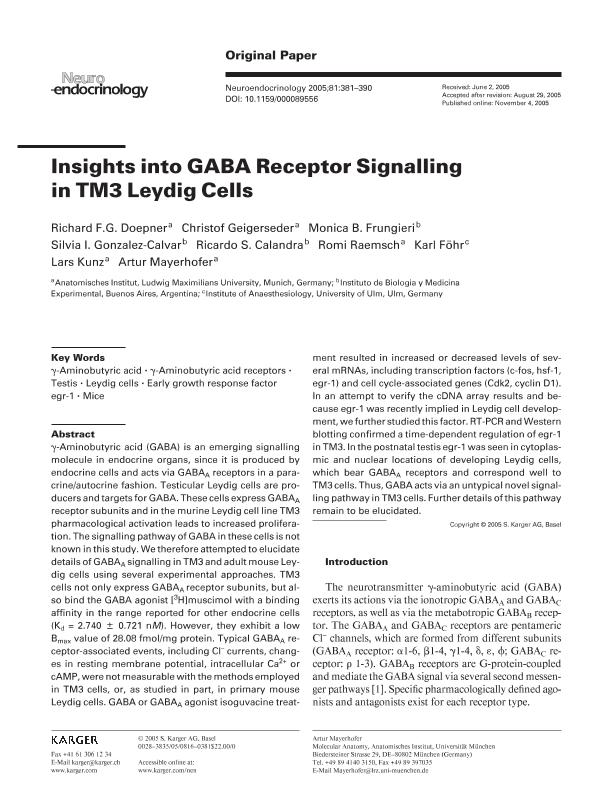Artículo
Insights into GABA receptor signalling in TM3 Leydig cells
Doepne, R. F. G,; Geigerseder, C.; Frungieri, Monica Beatriz ; Gonzalez Calvar, Silvia I.; Calandra, Ricardo Saul
; Gonzalez Calvar, Silvia I.; Calandra, Ricardo Saul ; Raemsch, R.; Fohr K,; Kunz, L.; Mayerhofer, A.
; Raemsch, R.; Fohr K,; Kunz, L.; Mayerhofer, A.
 ; Gonzalez Calvar, Silvia I.; Calandra, Ricardo Saul
; Gonzalez Calvar, Silvia I.; Calandra, Ricardo Saul ; Raemsch, R.; Fohr K,; Kunz, L.; Mayerhofer, A.
; Raemsch, R.; Fohr K,; Kunz, L.; Mayerhofer, A.
Fecha de publicación:
12/2005
Editorial:
Karger
Revista:
Neuroendocrinology
ISSN:
0028-3835
e-ISSN:
1423-0194
Idioma:
Inglés
Tipo de recurso:
Artículo publicado
Clasificación temática:
Resumen
Gamma-aminobutyric acid (GABA) is an emerging signalling molecule in endocrine organs, since it is produced by endocrine cells and acts via GABA(A) receptors in a paracrine/autocrine fashion. Testicular Leydig cells are producers and targets for GABA. These cells express GABA(A) receptor subunits and in the murine Leydig cell line TM3 pharmacological activation leads to increased proliferation. The signalling pathway of GABA in these cells is not known in this study. We therefore attempted to elucidate details of GABA(A) signalling in TM3 and adult mouse Leydig cells using several experimental approaches. TM3 cells not only express GABA(A )receptor subunits, but also bind the GABA agonist [(3)H]muscimol with a binding affinity in the range reported for other endocrine cells (K(d) = 2.740 +/- 0.721 nM). However, they exhibit a low B(max) value of 28.08 fmol/mg protein. Typical GABA(A) receptor-associated events, including Cl(-) currents, changes in resting membrane potential, intracellular Ca(2+) or cAMP, were not measurable with the methods employed in TM3 cells, or, as studied in part, in primary mouse Leydig cells. GABA or GABA(A) agonist isoguvacine treatment resulted in increased or decreased levels of several mRNAs, including transcription factors (c-fos, hsf-1, egr-1) and cell cycle-associated genes (Cdk2, cyclin D1). In an attempt to verify the cDNA array results and because egr-1 was recently implied in Leydig cell development, we further studied this factor. RT-PCR and Western blotting confirmed a time-dependent regulation of egr-1 in TM3. In the postnatal testis egr-1 was seen in cytoplasmic and nuclear locations of developing Leydig cells, which bear GABA(A) receptors and correspond well to TM3 cells. Thus, GABA acts via an atypical novel signalling pathway in TM3 cells. Further details of this pathway remain to be elucidated.
Palabras clave:
Leydig Cells
,
Testis
,
Aminobutyric Acid
Archivos asociados
Licencia
Identificadores
Colecciones
Articulos(IBYME)
Articulos de INST.DE BIOLOGIA Y MEDICINA EXPERIMENTAL (I)
Articulos de INST.DE BIOLOGIA Y MEDICINA EXPERIMENTAL (I)
Citación
Mayerhofer, A.; Kunz, L.; Fohr K,; Raemsch, R.; Calandra, Ricardo Saul; Gonzalez Calvar, Silvia I.; et al.; Insights into GABA receptor signalling in TM3 Leydig cells; Karger; Neuroendocrinology; 81; 6; 12-2005; 381-390
Compartir
Altmétricas



